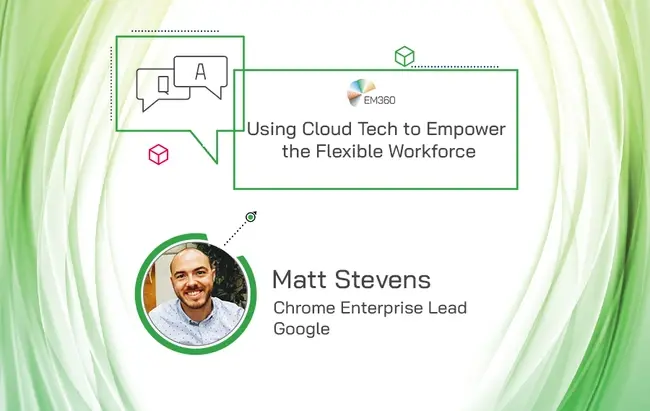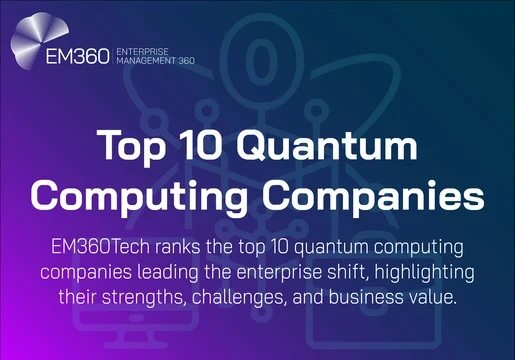Remote work; WFH; distance work; working from anywhere; telework; telecommute. These synonymous buzzwords have flooded every conversation in the nation since 2020. Collectively described as a work arrangement that enables employees to carry out their role responsibilities outside of the central place of work such as an office, the rising rates of remote work over the last year have completely transformed the way the world views employment. However, according to insights from Google, this way of working is neither phenomenal nor new. What is striking, is the current era of the flexible workforce and the emergence of a new employee persona - The Cloud Worker.
In this Q&A, we speak with cloud worker expert Matt Stevens, Chrome Enterprise Lead at Google. Matt recently led a keynote presentation at The Digital Transformation Conference London 2021, whereby he stressed that the time of The Cloud Worker is now.

1. What does Chrome mean when it talks about ‘The Cloud Worker’? Can you give us an archetype?
Cloud workers essentially refer to any members of the workforce who need flexibility in how, where and when they work. Cloud workers primarily use laptops or tablets. They expect to be able to work from any place that has an Internet connection, whether it’s an actual office, a home office, a cafe or a shop floor. They are able to do this because they make use of cloud apps, which allow them to easily access their files from any device. They rely on a suite of collaboration and productivity tools to stay connected wherever they are. Each cloud worker adds agility and flexibility to the enterprise. But once connected and in sync, they form the cloud workforce, helping organisations be resilient and productive in any kind of climate.
2. How would you describe the current era of the flexible workforce and where does The Cloud Worker fit into the conversation?
Whilst COVID-19 gave organisations an additional push to move to a more hybrid workforce, working outside the office is by no means a new trend. Businesses were already seeing the advantages of the cloud and how it made their workforces more flexible, agile, and modern. Pre-pandemic, between 2005 and 2018, there was a 173% increase in remote work*. Google has been tracking this growing trend through research over the last three years with Forrester. However, now due to lockdowns and 19 months of remote working, employees in almost every sector expect to have more flexibility and autonomy to decide when and how to perform their work. This means that cloud workers, who already have the tools to enable WFA work from anywhere), will be able to transition and adapt more seamlessly to the future of work.
3. What are the common, but less spoken about, benefits of flexibility and autonomy in the workplace?
Giving employees the power of choice and flexibility empowers them to be successful and create positive experiences at work. This in turn creates a stronger business culture and stickier customer relationships. When employees know they are the masters of their time, it creates an outcome-driven culture. Also, when your staff can collaborate easily irrespective of physical location, they can make decisions better and faster. Last but not least, the resilience that a truly empowered cloud workforce adds will be a critical part of business continuity planning, which will be a top priority for companies of all sizes as they look to the future.
4. Are there any key challenges that enterprises need to be aware of when putting together a flexible workforce strategy and workflow?
Although the world of work has progressed and evolved positively, some challenges remain. With a distributed workforce - and often distributed IT, it’s slow and difficult to get devices in the hands of employees. Disrupting existing infrastructure (think of an entire office desktop set-up with keyboard, monitor, docking station, mouse, headset and other peripherals) and replacing it with modern, lightweight and mobile devices can seem daunting. There’s also the risk of increased endpoint attacks with employees working from different locations and using different networks and systems. There has been a huge increase in cyber threats and attacks everywhere in the world in the last year, and in addition to these threats, there are new implications to consider from compliance and data handling, to device loss. Lastly, budget cuts and limited resources have caused IT to look for technology that provides better return on Investment.
5. What are your top tips for overcoming these obstacles?
When evaluating return to work strategies, organisations and IT departments must prioritise issues that pose a serious threat to the business, i.e. security. Ransomware, phishing attacks and other malicious actors can cause serious financial and reputational damage to a company in the long run. It doesn’t mean that choosing security as a driver will mean compromising on productivity or efficiency. You can have both while still ensuring lower Total Cost of Ownership, if you choose the right platform.
6. How are technologies such as Chrome OS empowering organisations to make the switch to flexible work and embrace the time of The Cloud Worker?
With solutions born and built in the cloud like Chrome OS, IT can provide a flexible, secure, fast-to-deploy, and easy-to-manage platform, offering devices that work the way employees do. Chrome OS ensures fast deployment with no imaging required. Devices can be drop shipped and will automatically enroll into domain with zero-touch enrollment. It also has built-in security and the ability to enforce 500+ policies, control updates, and install or manage apps from anywhere with the Google Admin Console. To solve the challenge of legacy endpoints, you can connect to legacy apps in secure virtual environments through integration with top VDI providers including Citrix, VMware, and Amazon Workspaces. Moreover, Chrome OS is a smart and eco-friendly investment. Chrome OS devices consume up to 46% less energy, have a lower device carbon footprint, and are built with sustainable and recyclable materials in partnership with our broader ecosystem.
*Source: Global Workplace Analytics: Latest Work Statistics, 2020







Comments ( 0 )